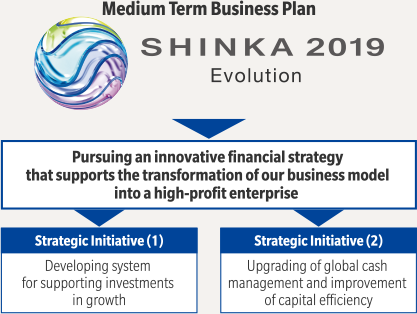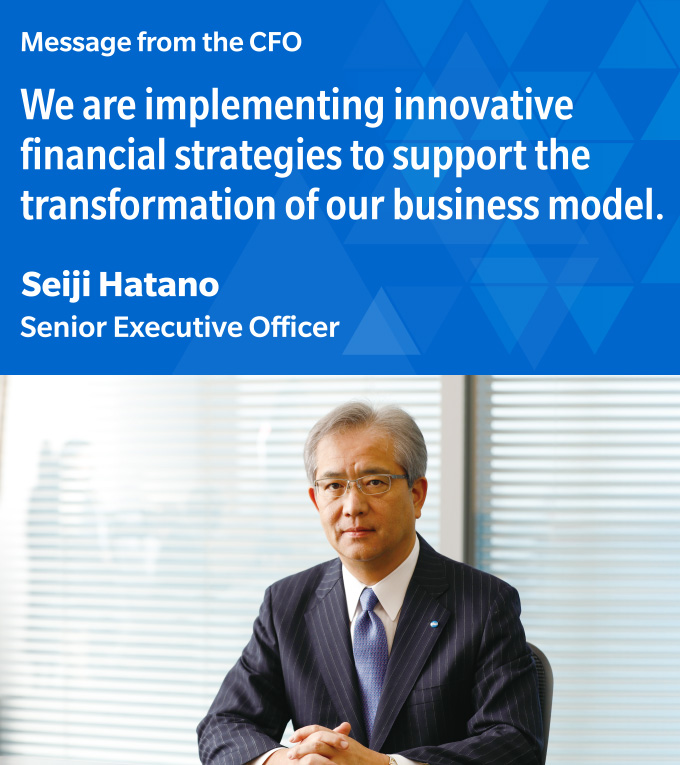Q1 What are the fundamental elements of Konica Minolta's capital policy?
Konica Minolta is working to transform its business model into a digital company with insight into implicit challenges. Toward this end, over the past several years we have actively pursued M&A deals. In fiscal 2017, we executed major M&A deals in the Healthcare Business valued in excess of ¥100 billion that included Ambry Genetics and Invicro, both of the United States. We funded these acquisitions with a hybrid loan (subordinated loan) intended to secure our financial soundness as well as maintain and improve capital efficiency.
The fundamental elements of Konica Minolta's capital policy include enhancing corporate value over the medium- to long-term through a focus on returns to shareholders and capital costs, working to further increase capital efficiency (ROE target: 9.5% in fiscal 2019 and 11% in fiscal 2021, and strengthening portfolio management while aiming to balance proactive investments in growth with our sound financial foundation. We are also stepping up our ability to generate cash flows. Our goal is to achieve an equity ratio of around 50% and net debt/equity ratio of 0.15x (for credit rating purposes) in fiscal 2019.
Investments in growth will continue to form an essential element of our business model transformation. Supporting the execution of our growth strategy financially speaking is my mission as CFO. I regularly tell Finance department employees that "Finance needs to have innovative thinking just like our business segments." As CFO, I am firmly committed to financial soundness and practicing innovative initiatives that improve capital efficiency (ROE and ROIC).
Basic Stance on Capital Policy
Konica Minolta is working to transform its business model into a digital company with insight into implicit challenges. We are implementing a capital policy optimized for supporting sustainable growth aimed at the medium- to long-term enhancement of corporate value. In particular, we are focusing on increasing our ability to generate cash flows and improving capital efficiency (ROE and ROIC). Toward this end, we will maintain a capital policy with an optimal balance between investments in growth, enhancing shareholder returns, and reinforcement of financial foundation. Our goal is to achieve an optimal capital and debt structure with an eye on capital efficiency and capital costs.
1. Improve capital efficiency
We emphasize capital cost and aim to increase ROE and ROIC in excess of capital cost in a stable and consistent manner. For this reason, we consider returns from invested capital* a major management indicator, and we seek to maximize corporate value through improved business portfolio management.
*Returns from invested capital: returns after deducting the cost of invested capital from business profits. This indicator shows the extent to which created value exceeds the cost of invested capital. Maximizing returns from invested capital increases ROE and ROIC.
2. Increase shareholder returns
We emphasize actively returning profits to shareholders while comprehensively taking into account consolidated earnings and the promotion of strategic investments in growth fields. We strive to enhance shareholder returns by consistently increasing the dividend and carefully timed share buybacks.
3. Ensure financial soundness
We reinforce our financial foundation underpinning proactive investments in growth by strengthening financial governance, minimizing financial risk, improving capital efficiency, and increasing shareholders' equity.
Balance sheet goals

*For credit rating purposes: 50% of the hybrid loan of 100 billion is recognized as shareholders’ equity
Q2
Konica Minolta has been an active player in M&A as a way to invest in growth.
What is your policy and stance on M&A and what areas do you emphasize in terms of PMI?
Konica Minolta acquired several dozens of companies during the course of the previous Medium Term Business Plan TRANSFORM 2016 until today. We view M&A as one way of promoting our growth strategy. In reviewing M&A deals, first we target domains where we can fully harness our own strengths, technologies and assets to generate synergies. Next, we carefully scrutinize market growth potential and compatibility with us based on detailed investigations and examinations carried out in advance. Additionally, we believe it is important that the executive management of the target company share our values, such as our corporate philosophy and vision. On top of this, we carry out due diligence from multiple perspectives, including on compatibility with business strategy, viability of business plan, and fairness of acquisition price, among others.
During the acquisition process, we conduct thorough due diligence concerning the target company's business model, technologies, management structure, accounting, synergistic effects and risks. Furthermore, as part of the post-merger integration (PMI) process, we implement a 100-day plan. This involves concentrating company-wide resources during the first 100 days after the merger to share our management vision with not only applicable business divisions, but also corporate divisions, to conduct thorough analysis of the target company's competence, and to visualize the management situation, in order to facilitate and solidify PMI. We also have rules in place for continued monitoring post acquisition as part of investment reviews. Particularly large acquisitions involve understanding the management situation and providing support promptly in case improvements are needed based on monthly discussions by the Management Executive Meeting and others. Under this framework, we leverage past M&A experiences to share what we learned as well as the know-how and experiences of the target company to build upon our company strengths and connect this to future growth.

Q3
Alongside investing in growth, what other measures are you implementing
in terms of upgrading cash management and improving capital efficiency?
Konica Minolta has introduced a global cash management system with the objective of visualizing the cash positions of Group companies and improving cash management. Looking ahead, we will focus on establishing global netting as a way to counteract foreign exchange volatility, and we will carry out effective foreign exchange risk hedging based on an accurate understanding of our foreign exchange exposure gained from more efficient cash management.
Following the addition of Group companies from M&A, there has been a growing number of cases where the head office finances the working capital needs of subsidiaries. As a result, in fiscal 2017 we carried out system upgrades to carefully check and monitor the cash movements of subsidiaries.
Going forward, we will emphasize capital costs and utilize returns from invested capital as a key management indicator, as we seek to improve capital efficiency and maximize corporate value.


